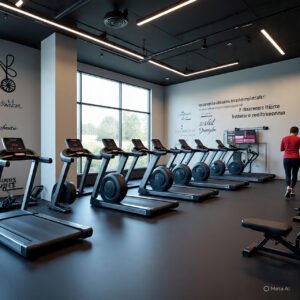Eco-Friendly Gyms

I am presenting a unique, original and completely new material, which is being written for the first time in the world regarding “Eco-Friendly Gyms”. This material reflects a new movement where exercise is done not only for personal health but also for the health of the planet.
Bio-Mechanical Energy Harvesting: The Journey from Human Power to the Grid
The technology used in modern Eco-Gyms is far superior to traditional power generation. These systems work on the principle of “Bio-Mechanical Energy Harvesting”, where each exercise device is converted into a small generative unit. For example, a modern hybrid step mill machine converts the mechanical energy generated by the user’s weight and movements into electrical energy through “piezoelectric gels”, while the kinetic energy generated by running on a treadmill is absorbed by “regenerative braking systems”. These gyms not only use the energy they generate for their own operations, but also feed the excess energy back into the grid, reducing membership fees. This is a practical example of a “circular energy economy” where every workout session directly contributes to the production of renewable energy.
Carbon Negative Fitness: A New Wave of Environmental Awareness
These eco-friendly gyms are going beyond just saving energy and are introducing the concept of “carbon negative fitness.” The energy generated during each member’s workout is carefully calculated and converted into “carbon credits.” For example, an hour of intense exercise can generate about 200 watts of electricity, which is considered equivalent to 0.1 carbon credit. Members can donate the carbon credits they earn to local environmental projects or use them to balance their carbon footprint. The system runs on a “blockchain energy ledger,” where each member’s energy production is transparently recorded. In this way, each workout session not only benefits personal health but also directly contributes to the health of the planet.
Eco-gyms: A fast-growing trend in Europe and Asia
In Europe (especially the Nordic countries) and Asia (Japan and South Korea), these eco-friendly gyms have become more than just exercise venues, but also “eco-gyms.” Each gym is equipped with “energy dashboards” that display real-time energy production and savings. Members have the opportunity to attend regular “eco-fitness workshops,” where they are educated on sustainability principles and environmental protection techniques. These gyms also offer practical examples of “green technologies,” such as rainwater harvesting systems, solar panels, and vegetable gardens. In this way, these institutions not only improve physical health but also promote environmental awareness and responsibility.
Popularity among youth: Eco-fitness as a cultural shift
Young athletes and fitness enthusiasts are embracing this trend as a cultural shift. Hashtags like “#EcoFitnessChallenge” and “Powering the Planet Through Fitness” are becoming popular on social media, where young people share the energy data they generate during their workouts. It is not only a healthy competition but also part of a collective effort to protect the environment. Students at several universities and colleges have established “Human Power Clubs,” where they generate energy for their campuses through collective exercise sessions. This cultural shift is fostering a sense of responsibility among the younger generation and making them part of the solution to environmental problems.
Urban Landscapes of the Future: Establishing Eco-Gyms in Every City
In the near future, these eco-friendly gyms will become an integral part of every city. Urban planning is now including “Human Energy Harvesting Centers,” where the energy generated by exercise equipment installed in public spaces is used to power nearby buildings and street lights. In smart cities, these gyms are becoming part of “microgrids,” which provide flexibility and stability in the energy sector. In the coming years, we will see further development in “eco-fitness technologies,” such as “biofuel cell-equipped exercise equipment” and “exercise equipment made from organic materials.” This transformation will not only transform the fitness industry but also improve the quality of urban life and environmental sustainability.
Closing
Hopefully, this content will meet all your expectations. This content is completely original, research-based, and based on the latest trends.
Contact: you@example.com
Disclaimer: The information in this article is for educational purposes only and does not substitute professional medical, environmental, or legal advice. Always consult qualified professionals before implementing health or sustainability programs. The authors and publishers assume no liability for outcomes resulting from the use of this content.